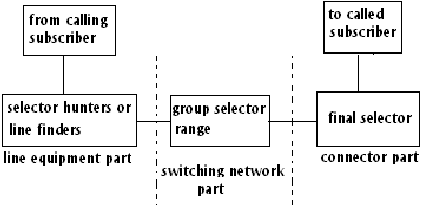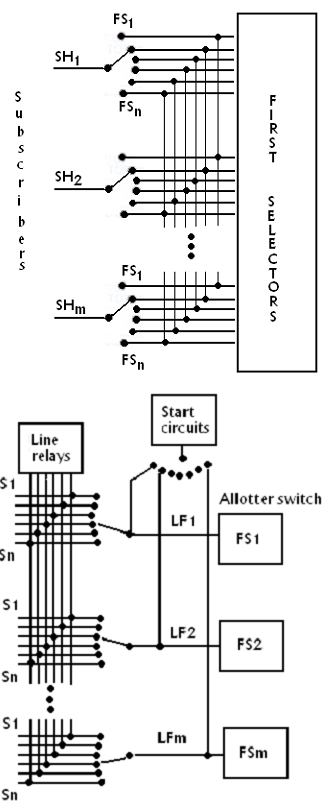What are the basic approaches to the design of subscriber access to Strowger systems? Describe them.
A step by step switching system has three main parts as demonstrated in figure. The line equipment part comprises selector hunters or line finders and another two parts comprises selectors. This selector hunter and line finders shows two fundamental methods in that a subscriber gains access to common switching resources. This selector hunter scheme is sometimes termed as subscriber uniselector scheme since there is a dedicated uniselector for all subscribers in the system. Line finders are connected with the first set of selectors in the switching matrix part and there is individual line finder for each selector into the set. The line equipment part is also termed as preselector stage. The selector hunters and line finders are generally referred to as preselectors.
The switching matrix part comprises one or more sets of two-motion selectors termed as first group selector, second group selector, and so on. The larger the exchange size, the larger is the number of group selector stages. The connector part comprises one set of two-motion selectors termed as final selectors.

FIG - Configuration of a Step-by-step Switching System
The selector hunter and line finder schemes are demonstrated in the trunking diagrams shown in figure in selector hunter based approach, while a subscriber lifts his hand set, the interrupter mechanism in his selector hunter finds activated and the wiper steps till a free first group selector is determined at the outlet. The status of the first group selector, free or busy, is termed by a signal in one of the bank contacts of the selector hunter. When a free first selector is sensed, the first selector is marked 'busy' and the interrupter is disabled. After that the first selector sends out a dial tone to the subscriber thorugh the selector hunter that simply gives an electrical path. Now the first selector is ready to receive the dialing pulses from the subscriber. This is possible that two selector hunters land on similar free first selector simultaneously and attempt to seize this. It is resolved by appropriate seizure circuit.

FIG - Subscriber Access to Strowger Switching System
In case of line finder based approach, the off-hook signal is sensed through all the line gets us. After that the interrupter mechanism of one of the finders, whose connected first selector is free, to get activated and the line finder wiper steps till this reach the contact on to that the subscriber is finished. On finding the line, the concerned first selector sends out the dial tone to the subscriber in readiness to receive the dial pulses. The selection of one of the line finders out of several free line finders is achieved using an allotter switch in the start circuit of the line finders as demonstrated in figure. If a subscriber lifts his receiver, the start signal from his relay in passed to the specific line finders via the common start circuit and the allotter switch. The line finder after that commences to hunt for the calling line. Once the calling line is found, the allotter switch steps to next free line finders. In consequence, the line finder and the associated first selector to be utilized for the next future call are selected in advance through the allotter circuit. In practical designs, some allotter switch is given in the system to serve calls which may originate simultaneously or in quick succession.